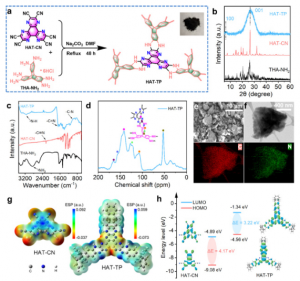3D polymer design powers record-high zinc–organic battery performance
FAYETTEVILLE, GA, UNITED STATES, October 22, 2025 /EINPresswire.com/ -- Organic cathodes have long been sought after for safe, sustainable, and recyclable energy storage, yet their development has been hampered by solubility, low voltage, and poor conductivity. In this study, researchers report a hexaazatriphenylene-based polymer with a three-dimensional (3D) framework that successfully addresses these challenges. The material exhibits remarkable insolubility, strong electronic delocalization, and accessible redox sites, resulting in a zinc–organic battery with an impressive initial discharge voltage of 1.32 V and an extraordinary lifespan of more than 40,000 cycles with over 93% capacity retention. This work provides a new molecular design strategy for creating high-voltage, ultrastable organic batteries.
Aqueous zinc batteries have attracted attention as next-generation energy storage devices due to their low cost, safety, and high capacity. However, zinc–organic batteries, which promise abundant raw materials and recyclability, face critical limitations such as low working voltage, poor cycling stability, and rapid capacity fading. Small molecules often dissolve, while one- and two-dimensional polymers suffer from restacking, leading to sluggish charge transfer. The introduction of three-dimensional (3D) polymer frameworks has shown success in lithium batteries but has rarely been applied to zinc–organic systems. Due to these issues, new strategies are urgently required to develop high-voltage, long-lifespan organic cathodes for aqueous zinc batteries.
A research team from Nanjing University of Posts and Telecommunications, the National University of Singapore, the Suzhou Institute of Nano-Tech and Nano-Bionics, and A*STAR (Singapore) has unveiled a hexaazatriphenylene-based polymer with a 3D architecture that sets new records for aqueous zinc–organic batteries. Published (DOI: 10.1016/j.esci.2025.100379) online on July, 2025, in eScience, the study demonstrates a cathode capable of delivering an initial discharge voltage of 1.32 V and maintaining 93.4% capacity after 40,000 cycles. This marks a significant step forward in designing durable, high-energy organic batteries.
The study introduces HAT-TP, a novel polymer formed by coupling hexaazatrinaphtylene (HAT-CN) and hexaaminotriptycene (THA-NH2) into a 3D framework. This architecture enhances stability by suppressing solubility and exposing abundant electroactive C=N sites for ion coordination. Characterizations, including XRD, FT-IR, NMR, and electron microscopy, confirmed the successful synthesis and porous 3D morphology. Electrochemical testing revealed a record initial discharge voltage of 1.32 V with a midpoint of 1.17 V, far surpassing conventional organic cathodes. The HAT-TP battery achieved ultralong cycling stability, retaining 93.4% of capacity after 40,000 cycles at 5 A g⁻¹, while maintaining nearly 100% Coulombic efficiency. Ex situ analyses and density functional theory simulations demonstrated a reversible Zn²⁺/H⁺ co-insertion mechanism, with five-electron transfer pathways driving high redox activity. Theoretical calculations showed stronger Gibbs free energy gains for Zn²⁺/H⁺ binding in HAT-TP compared with HAT-CN, explaining the higher discharge potential. Together, these features enable superior rate capability and energy densities up to 192.8 Wh kg⁻¹, highlighting the power of 3D molecular engineering in zinc–organic battery design.
“Our work demonstrates that 3D molecular polymerization is a powerful strategy to overcome long-standing barriers in zinc–organic batteries,” said corresponding authors Prof. Chaobin He, Prof. Wenyong Lai and Prof. Qichong Zhang. “By coupling hexaazatriphenylene with triptycene units, we created a stable, conductive, and highly active cathode material that combines high voltage with ultralong cycling life. The ability to retain more than 90% capacity over 40,000 cycles is unprecedented in this field, and it opens new possibilities for designing organic materials that are not only recyclable but also competitive with inorganic systems.”
The successful design of HAT-TP cathodes offers practical implications for advancing safe, sustainable, and high-performance energy storage. With its long lifespan and competitive energy density, this technology could support large-scale grid storage, where reliability and safety are critical, as well as flexible and wearable electronics requiring lightweight and environmentally friendly power sources. Beyond zinc–organic batteries, the principles of 3D polymer engineering demonstrated here can be extended to other electrochemical systems, including lithium-sulfur and sodium batteries. This research thus represents an important step toward next-generation organic batteries that merge sustainability with industrial practicality.
References
DOI
10.1016/j.esci.2025.100379
Original Source URL
https://doi.org/10.1016/j.esci.2025.100379
Funding Information
This work was supported by the National Natural Science Foundation of China (52203215), and the Natural Science Research Start-up Foundation of Recruiting Talents of Nanjing University of Posts and Telecommunications (Grant No. NY225035).
Lucy Wang
BioDesign Research
email us here
Legal Disclaimer:
EIN Presswire provides this news content "as is" without warranty of any kind. We do not accept any responsibility or liability for the accuracy, content, images, videos, licenses, completeness, legality, or reliability of the information contained in this article. If you have any complaints or copyright issues related to this article, kindly contact the author above.

